Anthony Charles Arruda
 Anthony Charles Arruda was born in New Bedford Massachusetts
in 1904 to Eliza and Manuel Arruda the oldest son in the family. The
Arruda family had a rough life growing up. The parents immigrated to the United
States in 1900, and struggled to make ends meet Manuel was a Insurance Salesman
in the New Bedford area. In 1914 Manuel Arruda returned to Portugal for health
reasons. Eliza did not wish to return to Portugal. She was determined to remain
in America and raised the family of five children on her own, so they
separated. The mother did the best she could raising her family but there
was very little money. This made their life very difficult, some of the
children were sent to an orphanage. Tony was the oldest so he went to work
instead of the orphanage. He worked at the New Bedford Textile Mills. He joined the Massachusetts Army National Guard on May 2, 1922 when he was 18 years old. He was assigned to F
Battery 241st Coast Artillery. He worked his way through the ranks until September 7, 1927 when he was promoted to
First Sergeant of the Battery. The First Sergeant duties were primary
administration and leadership of the battery. He remained in this position
until his discharge from the National Guard on May 3, 1938
Anthony Charles Arruda was born in New Bedford Massachusetts
in 1904 to Eliza and Manuel Arruda the oldest son in the family. The
Arruda family had a rough life growing up. The parents immigrated to the United
States in 1900, and struggled to make ends meet Manuel was a Insurance Salesman
in the New Bedford area. In 1914 Manuel Arruda returned to Portugal for health
reasons. Eliza did not wish to return to Portugal. She was determined to remain
in America and raised the family of five children on her own, so they
separated. The mother did the best she could raising her family but there
was very little money. This made their life very difficult, some of the
children were sent to an orphanage. Tony was the oldest so he went to work
instead of the orphanage. He worked at the New Bedford Textile Mills. He joined the Massachusetts Army National Guard on May 2, 1922 when he was 18 years old. He was assigned to F
Battery 241st Coast Artillery. He worked his way through the ranks until September 7, 1927 when he was promoted to
First Sergeant of the Battery. The First Sergeant duties were primary
administration and leadership of the battery. He remained in this position
until his discharge from the National Guard on May 3, 1938
MASSACHUSETTS NATIONAL GUARD
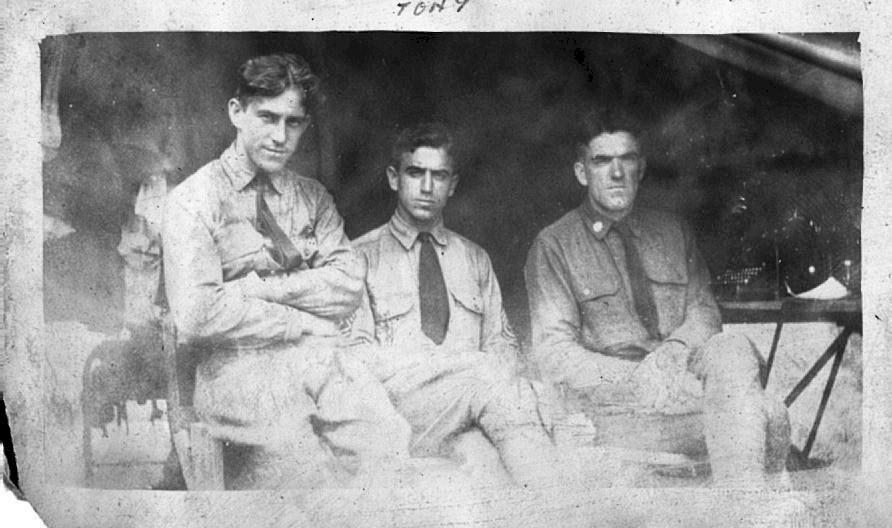 The Massachusetts National Guard is from one of America's first permanent
militia regiments. It is among the oldest continuing military unit in U.S.
history. The militia units were first organized by the Massachusetts Bay
Colony in 1636. Since then the Guard has participated in every U.S. conflict
from the Pequot War of 1637 to today's Operation Noble Eagle. The National
Guard is the direct descendent of the militias of the thirteen original English
colonies. The first English settlers brought many cultural influences and
English military ideas with them. For most of its history, England had no
full-time, professional Army. The English had relied on a militia of
citizen-soldiers who had the obligation to assist in national defense. The
National Guard started playing a more major role during World War I. Its units
were organized into divisions by state, and those divisions made up 40% of the
combat strength of the American Expeditionary Force. Three of the first five
U.S. Army divisions to enter combat in World War I were from the National Guard.
Further, the highest number of World War I Medals of Honor recipients were from
the 30th Division, made up of National Guardsmen from the Carolinas and
Tennessee. In between the wars was a period of reorganization. In the fall
of 1940, the nation's first peacetime draft was enacted and the National Guard
was called to active duty. The draft and mobilization were to last for only one
year, but in September 1941, the term of service for draftees and mobilized
Guardsmen was extended. Three months later the Japanese attacked Pearl Harbor
and the U.S. entered World War II. During WWII all 18 National Guard divisions
all saw combat, and were split between the Pacific and European theatres. Three
National Guard units participated in the heroic defense of Bataan in the
Philippines before finally surrendering to the Japanese in the spring of 1942.
When the U.S. Marines needed reinforcements on Guadalcanal in the autumn of
1942, North Dakota's 164th Infantry became the first large body of U.S. Army
troops to fight offensively in World War II. In the European theater, one
National Guard division, the 34th from Minnesota, Iowa, and South Dakota, was
the first to arrive overseas, and among the first into combat, in North Africa.
The 34th went on to spend the rest of the war fighting in Italy, and claimed
more actual combat days than any other World War II division. Massachusetts
National Guard during WWII was divide into different units. The Coast Artillery
units were deployed throughout New England on the Coast in defensive positions.
The 212th Field Artillery Battalion was a Massachusetts National Guard unit. It
was Federalized in World War II, and assigned to the Sixth
Armored Division, one of General George S. Patton's famous Third Army
divisions. The Infantry units were activated and served in the 26th
"Yankee" and 23rd"Americal" Infantry Divisions serving in
the European and the Pacific Theatre of operations. Uncle Tony served with the
Coast Artillery Unit of the Guard from 1922 until his discharge in 1938.
The Massachusetts National Guard is from one of America's first permanent
militia regiments. It is among the oldest continuing military unit in U.S.
history. The militia units were first organized by the Massachusetts Bay
Colony in 1636. Since then the Guard has participated in every U.S. conflict
from the Pequot War of 1637 to today's Operation Noble Eagle. The National
Guard is the direct descendent of the militias of the thirteen original English
colonies. The first English settlers brought many cultural influences and
English military ideas with them. For most of its history, England had no
full-time, professional Army. The English had relied on a militia of
citizen-soldiers who had the obligation to assist in national defense. The
National Guard started playing a more major role during World War I. Its units
were organized into divisions by state, and those divisions made up 40% of the
combat strength of the American Expeditionary Force. Three of the first five
U.S. Army divisions to enter combat in World War I were from the National Guard.
Further, the highest number of World War I Medals of Honor recipients were from
the 30th Division, made up of National Guardsmen from the Carolinas and
Tennessee. In between the wars was a period of reorganization. In the fall
of 1940, the nation's first peacetime draft was enacted and the National Guard
was called to active duty. The draft and mobilization were to last for only one
year, but in September 1941, the term of service for draftees and mobilized
Guardsmen was extended. Three months later the Japanese attacked Pearl Harbor
and the U.S. entered World War II. During WWII all 18 National Guard divisions
all saw combat, and were split between the Pacific and European theatres. Three
National Guard units participated in the heroic defense of Bataan in the
Philippines before finally surrendering to the Japanese in the spring of 1942.
When the U.S. Marines needed reinforcements on Guadalcanal in the autumn of
1942, North Dakota's 164th Infantry became the first large body of U.S. Army
troops to fight offensively in World War II. In the European theater, one
National Guard division, the 34th from Minnesota, Iowa, and South Dakota, was
the first to arrive overseas, and among the first into combat, in North Africa.
The 34th went on to spend the rest of the war fighting in Italy, and claimed
more actual combat days than any other World War II division. Massachusetts
National Guard during WWII was divide into different units. The Coast Artillery
units were deployed throughout New England on the Coast in defensive positions.
The 212th Field Artillery Battalion was a Massachusetts National Guard unit. It
was Federalized in World War II, and assigned to the Sixth
Armored Division, one of General George S. Patton's famous Third Army
divisions. The Infantry units were activated and served in the 26th
"Yankee" and 23rd"Americal" Infantry Divisions serving in
the European and the Pacific Theatre of operations. Uncle Tony served with the
Coast Artillery Unit of the Guard from 1922 until his discharge in 1938.
COAST ARTILLERY CORPS
 The idea of coast defense is not a new one nor is it specifically an American
idea. The idea of fortifying ports with artillery against Naval invaders goes back to the
earliest of times when man first took to sea in ships to conquer other lands.
The United States sought its own security against attack through its own
fortification of its maritime ports. Fortifications were viewed as a way
to avoid war and gave the American people a sense of security. This
thinking had a strong influence on national defense policy making and
construction of these fortifications was nearly a substitute for any other form
of military policy. Fortifications were built throughout the coastline of
America's shores and were defended by local militias. By the end of World War I
many of the coast defense forts maintained by a small number of soldiers, and
used as summer training
The idea of coast defense is not a new one nor is it specifically an American
idea. The idea of fortifying ports with artillery against Naval invaders goes back to the
earliest of times when man first took to sea in ships to conquer other lands.
The United States sought its own security against attack through its own
fortification of its maritime ports. Fortifications were viewed as a way
to avoid war and gave the American people a sense of security. This
thinking had a strong influence on national defense policy making and
construction of these fortifications was nearly a substitute for any other form
of military policy. Fortifications were built throughout the coastline of
America's shores and were defended by local militias. By the end of World War I
many of the coast defense forts maintained by a small number of soldiers, and
used as summer training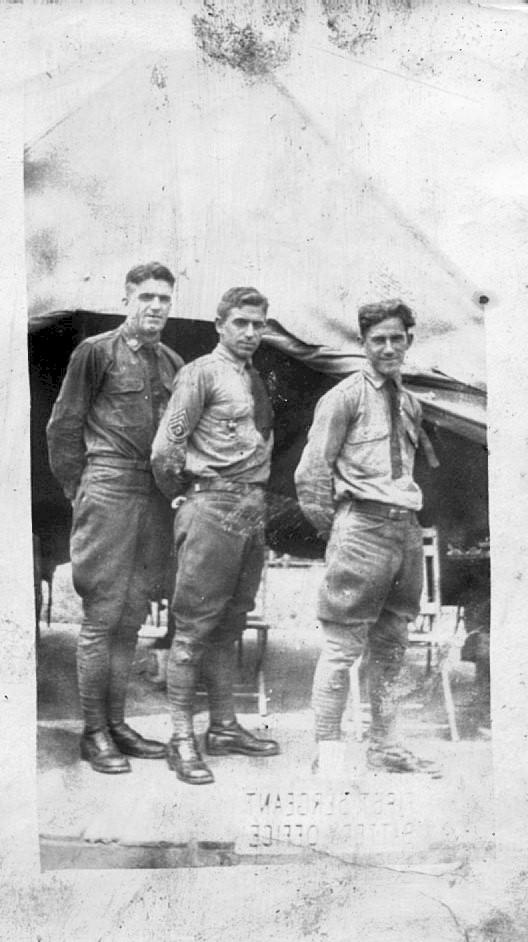 camps for Army Reserve, National Guard, Reserve Officers Training Corps (ROTC),
as well as the Civilian Military Training Corps (CMTC) units. New long-range
12-inch and 16-inch army ordnance for sea-coast armament was built during this
period and supplemented by 16-inch naval guns made available as the result of
naval reductions due to the Washington Naval Treaty of 1922. A number of new
harbor defense construction plans were drawn up, but few
new batteries were actually built during the this period due to fiscal
constraints. The growing importance of aircraft as an offensive weapon resulted
in the formation and training of specialized Coast Artillery Corps antiaircraft
artillery units during this period. A number of antiaircraft guns were installed
at all harbor defense reservations during WWI and years thereafter. When the
Threat of another war loomed on the horizon the United States started rearming
the American coastline with the long range 16-inch weapons.. A new construction
program was authorized by Congress in September of 1940. The program planned for
new defense at some 19 harbors along both coasts of North America. When America
entered the war in December of 1941, a large number of mobile weapons were
rushed to both coasts. A number of other "temporary" seacoast defenses
were built using old naval weapons and relocated Army seacoast weapons.
camps for Army Reserve, National Guard, Reserve Officers Training Corps (ROTC),
as well as the Civilian Military Training Corps (CMTC) units. New long-range
12-inch and 16-inch army ordnance for sea-coast armament was built during this
period and supplemented by 16-inch naval guns made available as the result of
naval reductions due to the Washington Naval Treaty of 1922. A number of new
harbor defense construction plans were drawn up, but few
new batteries were actually built during the this period due to fiscal
constraints. The growing importance of aircraft as an offensive weapon resulted
in the formation and training of specialized Coast Artillery Corps antiaircraft
artillery units during this period. A number of antiaircraft guns were installed
at all harbor defense reservations during WWI and years thereafter. When the
Threat of another war loomed on the horizon the United States started rearming
the American coastline with the long range 16-inch weapons.. A new construction
program was authorized by Congress in September of 1940. The program planned for
new defense at some 19 harbors along both coasts of North America. When America
entered the war in December of 1941, a large number of mobile weapons were
rushed to both coasts. A number of other "temporary" seacoast defenses
were built using old naval weapons and relocated Army seacoast weapons.  The
seacoast defense construction program went into high gear in 1942, with priority
for the sites along the Pacific coast. However, after the Battle of Midway in
June of 1942, the possibility of a Japanese attack on the American mainland
diminished. As a result the construction program was curtailed in 1944.Atthe end
of World War II the Coast Artillery program was cancelled due to the improvement
in amphibious landing tactics and the use of the air power had made fixed
coastal defenses obsolete. During the 1950's the United States experimented with
missile defense of its port facilities in key areas but even these were
discontinued by the 1960's Today there is much talk about the Star Wars
missile defense program, but it is in experimental development stage. But, who
knows maybe someday the descendant of the Coast Artillery may still yet be
defending the country against attack.
The
seacoast defense construction program went into high gear in 1942, with priority
for the sites along the Pacific coast. However, after the Battle of Midway in
June of 1942, the possibility of a Japanese attack on the American mainland
diminished. As a result the construction program was curtailed in 1944.Atthe end
of World War II the Coast Artillery program was cancelled due to the improvement
in amphibious landing tactics and the use of the air power had made fixed
coastal defenses obsolete. During the 1950's the United States experimented with
missile defense of its port facilities in key areas but even these were
discontinued by the 1960's Today there is much talk about the Star Wars
missile defense program, but it is in experimental development stage. But, who
knows maybe someday the descendant of the Coast Artillery may still yet be
defending the country against attack.
241st Coast Artillery Regiment
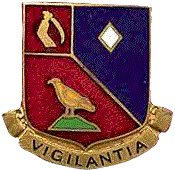 The 241st Artillery unit was a unit
assigned to the Massachusetts National Guard.
It was stationed throughout New England and Uncle Tony was part of it. It is
believed that he was part of the unit that was assigned to Fort
Taber in New Bedford Massachusetts. Fort Rodman was the
The 241st Artillery unit was a unit
assigned to the Massachusetts National Guard.
It was stationed throughout New England and Uncle Tony was part of it. It is
believed that he was part of the unit that was assigned to Fort
Taber in New Bedford Massachusetts. Fort Rodman was the  Army's officially
name for the installation and it was completed on May 11, 1861. Brass and iron
cannons were mounted to protect the Clark’s Cove and Acushnet River approaches
to New Bedford. This installation was temporarily named Fort Taber, in honor of
the city’s chief executive. As the granite fort was yet unnamed and appeared
on government records simply as “the fort at Clark’s Point” so it was natural
to refer to it locally as Fort Taber. This local diction persists
even today. In 1898 the entire military property was officially named in honor
of Lt. Col. William Logan Rodman of New Bedford, killed in the Civil War battle
at Port Hudson, Louisiana. At the turn of the century, Fort Rodman was place on
caretaker basis, with a small body of troops to insure the protection of weapons
and federal property. During that period, the remainder of the modernized
seacoast artillery batteries was completed. The gradual build up of port defense
continued
Army's officially
name for the installation and it was completed on May 11, 1861. Brass and iron
cannons were mounted to protect the Clark’s Cove and Acushnet River approaches
to New Bedford. This installation was temporarily named Fort Taber, in honor of
the city’s chief executive. As the granite fort was yet unnamed and appeared
on government records simply as “the fort at Clark’s Point” so it was natural
to refer to it locally as Fort Taber. This local diction persists
even today. In 1898 the entire military property was officially named in honor
of Lt. Col. William Logan Rodman of New Bedford, killed in the Civil War battle
at Port Hudson, Louisiana. At the turn of the century, Fort Rodman was place on
caretaker basis, with a small body of troops to insure the protection of weapons
and federal property. During that period, the remainder of the modernized
seacoast artillery batteries was completed. The gradual build up of port defense
continued  throughout the early part of the century. During the First World
War the Harbor Defenses were increased dramatically. After the the war the build
up tapered off and on February 27, 1924 the harbor defense artillery went under
reorganization. The Coast Artillery was regrouped into regiments, having previously been organized into separate companies during the reorganization of 1901. The method of designation of these companies varied several times during the intervening twenty-three years, but at the time of reorganization these units were numbered serially throughout the Corps.
throughout the early part of the century. During the First World
War the Harbor Defenses were increased dramatically. After the the war the build
up tapered off and on February 27, 1924 the harbor defense artillery went under
reorganization. The Coast Artillery was regrouped into regiments, having previously been organized into separate companies during the reorganization of 1901. The method of designation of these companies varied several times during the intervening twenty-three years, but at the time of reorganization these units were numbered serially throughout the Corps.
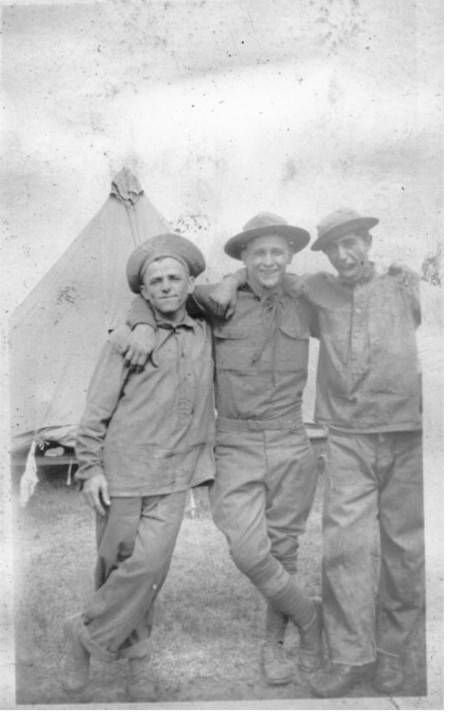 The reorganization into regiments brought about in effect, the reconstitution of the seven artillery regiments that were disbanded in 1901 and created nine others in the regular Army designated 1st through 16th Coast Artillery (Harbor Defense or HD). Two other regiments were organized from Philippine Scout Companies manning harbor defenses and designated the 91st and 92nd Coast Artillery (HD). Later one other regiment was established as a requirement by the Panama Canal Defense Project and was constituted as the 17th Coast Artillery (HD). There were thus nineteen regiments provided for in the Regular Army. Parallel with this regrouping in the regular Army, the separate companies of harbor defense artillery in the National Guard were Also formed into regiments commencing with the 240th Coast
Artillery (HD) in Maine, the 241st in Massachusetts, 242nd in Connecticut, 243rd in Rhode Island, 244th and 245th in NY, 246th VA, 248th WA, 249th OR, 250th and 251st, CA, 252nd NC, 260th Wash DC, 261st DE, 263rd SC, 264th GA, and finally
The reorganization into regiments brought about in effect, the reconstitution of the seven artillery regiments that were disbanded in 1901 and created nine others in the regular Army designated 1st through 16th Coast Artillery (Harbor Defense or HD). Two other regiments were organized from Philippine Scout Companies manning harbor defenses and designated the 91st and 92nd Coast Artillery (HD). Later one other regiment was established as a requirement by the Panama Canal Defense Project and was constituted as the 17th Coast Artillery (HD). There were thus nineteen regiments provided for in the Regular Army. Parallel with this regrouping in the regular Army, the separate companies of harbor defense artillery in the National Guard were Also formed into regiments commencing with the 240th Coast
Artillery (HD) in Maine, the 241st in Massachusetts, 242nd in Connecticut, 243rd in Rhode Island, 244th and 245th in NY, 246th VA, 248th WA, 249th OR, 250th and 251st, CA, 252nd NC, 260th Wash DC, 261st DE, 263rd SC, 264th GA, and finally
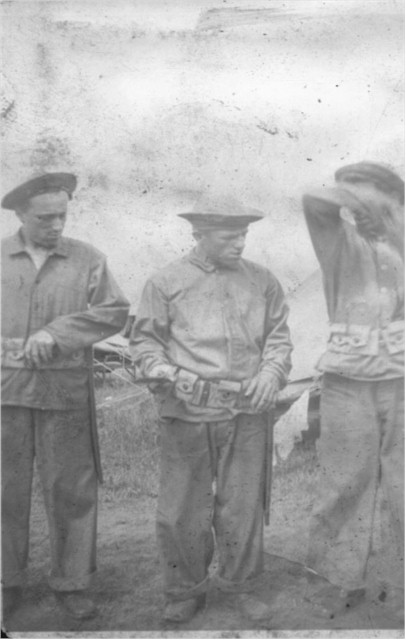 the 265th in Florida. Later the 244th, 250th, 251st, 252nd, and 260th were converted to other types, leaving twelve harbor defense regiments and battalions in the National Guard. The Harbor defenses were divided into batteries designated by a letter or number.
In
the Coast Artillery the following Non-commissioned officers and graded men were
authorized: Sergeant Major, Senior Grade; Sergeant Major, Junior Grade; First
Sergeant, Quartermaster Sergeant; Sergeant; and Corporal. Uncle Tony was F
battery's First Sergeant assigned to administration duties such as filling
out morning reports and working in the administration office. Each harbor defense was manned with an active duty
the 265th in Florida. Later the 244th, 250th, 251st, 252nd, and 260th were converted to other types, leaving twelve harbor defense regiments and battalions in the National Guard. The Harbor defenses were divided into batteries designated by a letter or number.
In
the Coast Artillery the following Non-commissioned officers and graded men were
authorized: Sergeant Major, Senior Grade; Sergeant Major, Junior Grade; First
Sergeant, Quartermaster Sergeant; Sergeant; and Corporal. Uncle Tony was F
battery's First Sergeant assigned to administration duties such as filling
out morning reports and working in the administration office. Each harbor defense was manned with an active duty
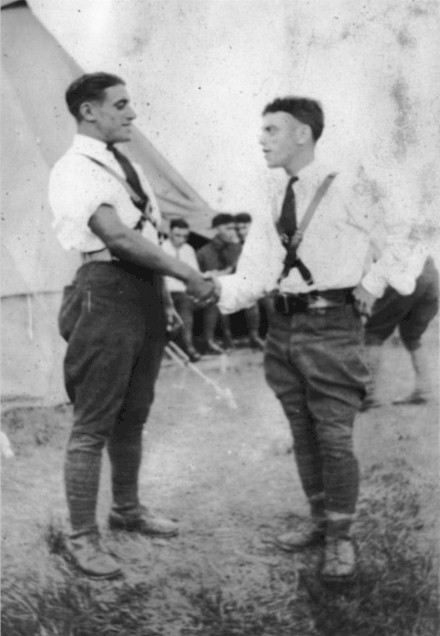 Coast Artillery Battery. Fort Rodman fell under the 10th Coast Artillery. Battery E consisted of one officer and 13 Enlisted Men, which was later reduced to a caretaker status of 6 enlisted men in 1930 the responsibility of Fort Rodman was to man the Coast Defenses of Narragansett Bay. The regimental HQ was located at Fort Adams R.I. Fort Rodman was augmented by The Massachusetts National Guards' 241st
Coast Artillery regiment. Local men from the New Bedford area would man the fort
in the event of an attack. After his retirement from the National Guard Uncle Tony remained in the New
Bedford area until his death. He is survived by his children Anthony, Jr.,
Bill, Norma, John, Gerry, Maria, and Edward. Click
here For more information on Coast Artillery Installations
Coast Artillery Battery. Fort Rodman fell under the 10th Coast Artillery. Battery E consisted of one officer and 13 Enlisted Men, which was later reduced to a caretaker status of 6 enlisted men in 1930 the responsibility of Fort Rodman was to man the Coast Defenses of Narragansett Bay. The regimental HQ was located at Fort Adams R.I. Fort Rodman was augmented by The Massachusetts National Guards' 241st
Coast Artillery regiment. Local men from the New Bedford area would man the fort
in the event of an attack. After his retirement from the National Guard Uncle Tony remained in the New
Bedford area until his death. He is survived by his children Anthony, Jr.,
Bill, Norma, John, Gerry, Maria, and Edward. Click
here For more information on Coast Artillery Installations

 They
Served with Honor : Home Page
They
Served with Honor : Home Page